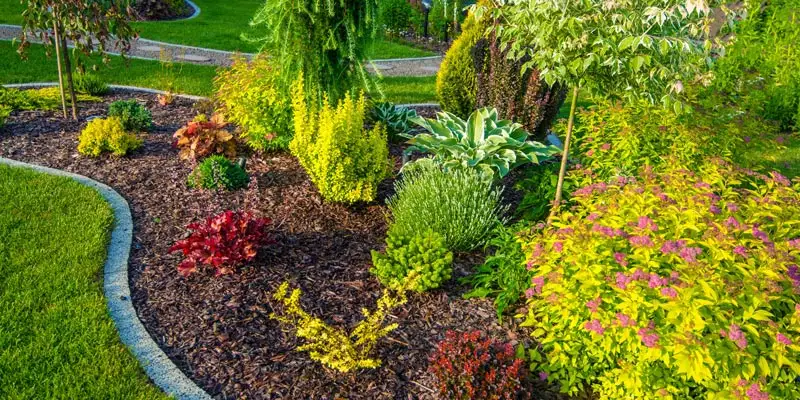The Of Landscape Design
The Only Guide to Landscape Design
Table of ContentsThe Only Guide to Landscape DesignUnknown Facts About Landscape DesignLandscape Design for DummiesLandscape Design Fundamentals Explained
A lawn can generally be divided right into 3 locations: public (the front yard), exclusive (the back yard), and solution (generally the side lawn). The place of task locations depends largely on the type of area, the dimension of area needed, the type of activity, and the desired closeness to various other tasks and frameworks.
The outside wall surface of your house often functions as the initial wall surface or beginning point of an exterior space. Inappropriate usages should be divided, and related activities, such as food preparation and dining, ought to be created to make the yard extra efficient and delightful. When utilizing hardscape to create spaces, use building product similar to that used in the home for continuity from your house right into the yard.
Connected rooms. Credit: Gail Hansen, UF/IFAS Using similar hardscape features and repeating plants pulls the eye around the yard. Essential points in the process can be emphasized with growings or attributes that attract attention and motivate motion in a specific direction. Relocating along the course takes an individual from one location to the next and allows the user to have a variety of experiences.
This supplies a sense of mystery that promotes expedition and discovery of the landscape. From a design perspective, plant products have three significant features in the landscape: aesthetic, architectural and utilitarian. Aesthetically, plants create a visually positive environment and structurally plants arrange and define spaces. Plants are practical due to the fact that they can change the setting for the convenience of the user by changing light, temperature level and moisture.
Unknown Facts About Landscape Design
For mental convenience plants are made use of as physical or implied barriers for privacy and security. Physical obstacles obstruct both the sight and accessibility to a room and include fences, walls and plant hedges.
Physical and implied barriers. Debt: Gail Hansen, UF/IFAS For these reasons, the kinds of plants to be made use of (such as trees, hedges, or groundcovers) should be chosen in the early stages of planning. Plant types are chosen for their practical abilities to ensure that their future function and needed area can be taken into consideration at the very same time.
The overhead plane, the vertical aircraft and the ground airplane need to all be thought about to create unit. As soon as the form of a plant bed has been established, the plants ought to be massed (grouped) and layered to accomplish aesthetic unity and the preferred amount of unit. The dimension of a plant mass will certainly depend upon the total size of the yard, the dimension of the private plants in the mass, and the emphasis or impact preferred from the plant material.
Each plant mass is in front of, behind, or following to, one more mass. Credit: Gail Hansen, UF/IFAS Repeating plants within a mass and duplicating masses with similar plants links the garden with each other. The individual plant features have to be taken into consideration to efficiently layer and mass plants.
What Does Landscape Design Do?
All plant compositions begin with the main structure plants, the huge, mostly evergreen background plants-such as the trees and big hedges. These plants different or enframe spaces, control the dimension of the room, and provide the starting factor for choosing the suitable attributes of the second layer, midground plants, for massing and infill.
Crucial factors in the yard need to be highlighted by the use of unique plants, distinct structures, or garden ornaments. Marking thresholds or entrances to rooms can be performed with gates, arbors, and steps, or through using unique and colorful plants. The form and/or style theme of the garden will certainly typically aid figure out the essential next page factors and how they need to be highlighted.
Other vital locations in the yard are focal points, which is used to aesthetically organize a landscaped location. Various viewpoints or viewpoints can disclose various make-ups in the landscape that may call for a range of focal points.
Indicators on Landscape Design You Need To Know
Number 13. Plant forms. Credit Rating: Gail Hansen, UF/IFAS After kind, texture is the following leading attribute of a plant; rugged, tool and great structures can be made use of for comparison and emphasis in the landscape. Type and structure both trump shade in the garden for most of the year. During certain seasons, color will be the most visible attribute of the yard.


The pleasant scent of plants, the noise of wind in the trees, the audio and appearance of water, and the colors and click appearances of sculptures, pots and yard furnishings all contribute to the experience of the yard. One information that is frequently neglected is the result of light on the appearances of the plants.
The whole yard modifications in feature and look over the training course of the day, and the training course of a year, as the light and temperature level modification from early morning to evening and period to season. Plant choice need to think about a plant's development price, its mature size and form, and the maintenance it will certainly call for.
It is very important to recognize the ultimate mature dimension of plants so they can be positioned in the right area and spaced correctly when they are installed. Providing plants area to expand is a difficulty since the typical fully grown size is commonly based on ideal expanding problems and the ecological problems of a website may cause a plant to browse around this site expand bigger or stay smaller sized.